九种状语从句
状语从句的九种常见类型
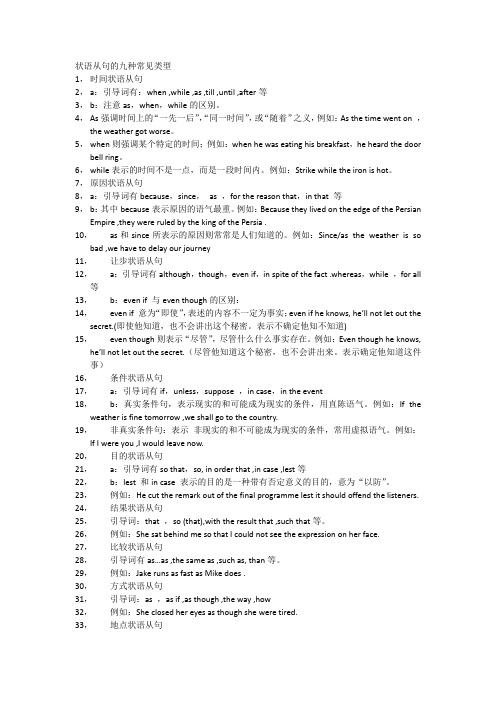
状语从句的九种常见类型1,时间状语从句2,a:引导词有:when ,while ,as ,till ,until ,after等3,b:注意as,when,while的区别。
4,As强调时间上的“一先一后”,“同一时间”,或“随着”之义,例如:As the time went on ,the weather got worse。
5,when则强调某个特定的时间;例如:when he was eating his breakfast,he heard the door bell ring。
6,while表示的时间不是一点,而是一段时间内。
例如:Strike while the iron is hot。
7,原因状语从句8,a:引导词有because,since,as ,for the reason that,in that 等9,b:其中because表示原因的语气最重。
例如:Because they lived on the edge of the Persian Empire ,they were ruled by the king of the Persia .10,as和since所表示的原因则常常是人们知道的。
例如:Since/as the weather is so bad ,we have to delay our journey11,让步状语从句12,a:引导词有although,though,even if,in spite of the fact .whereas,while ,for all 等13,b:even if 与even though的区别:14,even if 意为“即使”,表述的内容不一定为事实;even if he knows, he’ll not let out the secret.(即使他知道,也不会讲出这个秘密。
表示不确定他知不知道)15,even though则表示“尽管”,尽管什么什么事实存在。
英语状语从句的九种类型
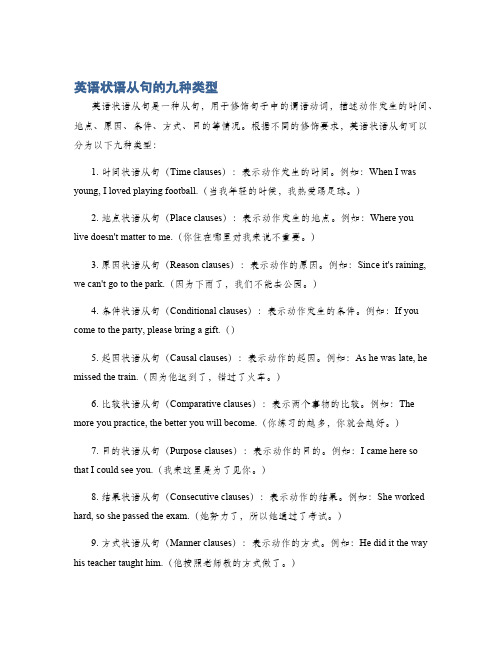
英语状语从句的九种类型英语状语从句是一种从句,用于修饰句子中的谓语动词,描述动作发生的时间、地点、原因、条件、方式、目的等情况。
根据不同的修饰要求,英语状语从句可以分为以下九种类型:1. 时间状语从句(Time clauses):表示动作发生的时间。
例如:When I was young, I loved playing football.(当我年轻的时候,我热爱踢足球。
)2. 地点状语从句(Place clauses):表示动作发生的地点。
例如:Where youlive doesn't matter to me.(你住在哪里对我来说不重要。
)3. 原因状语从句(Reason clauses):表示动作的原因。
例如:Since it's raining, we can't go to the park.(因为下雨了,我们不能去公园。
)4. 条件状语从句(Conditional clauses):表示动作发生的条件。
例如:If you come to the party, please bring a gift.()5. 起因状语从句(Causal clauses):表示动作的起因。
例如:As he was late, he missed the train.(因为他迟到了,错过了火车。
)6. 比较状语从句(Comparative clauses):表示两个事物的比较。
例如:The more you practice, the better you will become.(你练习的越多,你就会越好。
)7. 目的状语从句(Purpose clauses):表示动作的目的。
例如:I came here so that I could see you.(我来这里是为了见你。
)8. 结果状语从句(Consecutive clauses):表示动作的结果。
例如:She worked hard, so she passed the exam.(她努力了,所以她通过了考试。
九大状语从句顺口溜
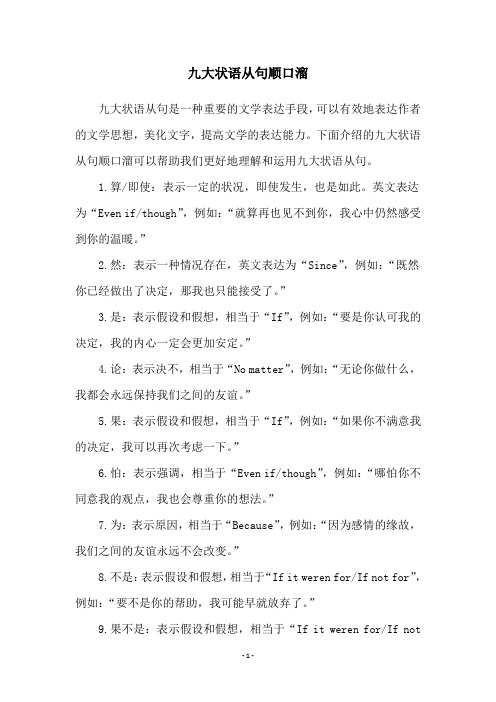
九大状语从句顺口溜九大状语从句是一种重要的文学表达手段,可以有效地表达作者的文学思想,美化文字,提高文学的表达能力。
下面介绍的九大状语从句顺口溜可以帮助我们更好地理解和运用九大状语从句。
1.算/即使:表示一定的状况,即使发生,也是如此。
英文表达为“Even if/though”,例如:“就算再也见不到你,我心中仍然感受到你的温暖。
”2.然:表示一种情况存在,英文表达为“Since”,例如:“既然你已经做出了决定,那我也只能接受了。
”3.是:表示假设和假想,相当于“If”,例如:“要是你认可我的决定,我的内心一定会更加安定。
”4.论:表示决不,相当于“No matter”,例如:“无论你做什么,我都会永远保持我们之间的友谊。
”5.果:表示假设和假想,相当于“If”,例如:“如果你不满意我的决定,我可以再次考虑一下。
”6.怕:表示强调,相当于“Even if/though”,例如:“哪怕你不同意我的观点,我也会尊重你的想法。
”7.为:表示原因,相当于“Because”,例如:“因为感情的缘故,我们之间的友谊永远不会改变。
”8.不是:表示假设和假想,相当于“If it weren for/If not for”,例如:“要不是你的帮助,我可能早就放弃了。
”9.果不是:表示假设和假想,相当于“If it weren for/If notfor”,例如:“如果不是你的爱,我可能已经失去了信心。
”九大状语从句可以有效地传达作者的思想与感受,强化文章的表达力度,而且用起来也非常简单。
上述九大状语从句顺口溜,是帮助我们更加深入地理解九大状语从句的重要参考,有了这些知识点,我们就可以更加有效和熟练地使用九大状语从句了。
举例来看,就算大家都拼命工作,也难以摆脱日益增加的压力;既然责任委托于每个人,那么我们就必须学会将责任落实到具体行动;要是大家都能拿出足够的耐心和勇气,那么我们必将取得更大的成功;无论发生什么事情,我们都要和谐共处;如果我们能够把理想落实到现实,那么就一定会取得良好的成绩;哪怕梦想遥不可及,我们也要勇往直前;因为只有持续的努力才能取得更好的发展;要不是你的鼓励,我也许早就放弃了;如果不是你的支持,我也许早就走入歧途。
英语中的九种状语从句
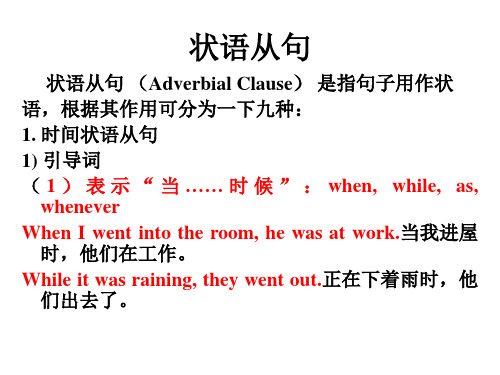
5、条件状语从句的引导词有if, if only(如果…… 就好了,但愿), unless, in case, as/so long as, provided that, providing that, suppose that, supposing that, on condition that , when。
(1)___the days went on, the weather got worse.
A. With
B. Since
C. While D. As
(2) ____the satellite launch drawing near,the research workers put their hearts to the test and always stayed up late.
状语从句
状语从句 (Adverbial Clause) 是指句子用作状 语,根据其作用可分为一下九种:
1. 时间状语从句 1) 引导词 ( 1 ) 表 示 “ 当 …… 时 候 ” : when, while, as,
whenever When I went into the room, he was at work.当我进屋
Even if I have to walk all the way I’ll get there. 即使我 得一路走着去,我也要走到那里。
• as引导的让步状语从句的结构是:名词(形 容词、副词、动词)+ as +主谓。如:
Child as he was, he knew what was the right thing to do. 尽管是个孩子,他知道要做的正确的事情 是什么。
状语从句
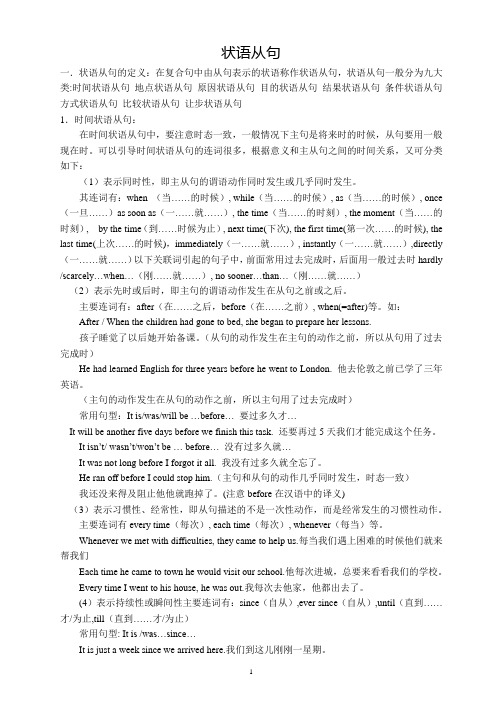
状语从句一.状语从句的定义:在复合句中由从句表示的状语称作状语从句,状语从句一般分为九大类:时间状语从句地点状语从句原因状语从句目的状语从句结果状语从句条件状语从句方式状语从句比较状语从句让步状语从句1.时间状语从句:在时间状语从句中,要注意时态一致,一般情况下主句是将来时的时候,从句要用一般现在时。
可以引导时间状语从句的连词很多,根据意义和主从句之间的时间关系,又可分类如下:(1)表示同时性,即主从句的谓语动作同时发生或几乎同时发生。
其连词有:when (当……的时候), while(当……的时候), as(当……的时候), once (一旦……)as soon as(一……就……), the time(当……的时刻), the moment(当……的时刻),by the time(到……时候为止), next time(下次), the first time(第一次……的时候), the last time(上次……的时候),immediately(一……就……), instantly(一……就……),directly (一……就……)以下关联词引起的句子中,前面常用过去完成时,后面用一般过去时hardly /scarcely…when…(刚……就……), no sooner…than…(刚……就……)(2)表示先时或后时,即主句的谓语动作发生在从句之前或之后。
主要连词有:after(在……之后,before(在……之前), when(=after)等。
如:After / When the children had gone to bed, she began to prepare her lessons.孩子睡觉了以后她开始备课。
(从句的动作发生在主句的动作之前,所以从句用了过去完成时)He had learned English for three years before he went to London. 他去伦敦之前已学了三年英语。
英语状语从句的九种类型

英语状语从句的九种类型状语从句是英语语法中非常重要的一部分,它们能够为句子提供额外的信息以及更加丰富的语境。
状语从句可以用来描述时间、地点、原因、方式等等,根据不同的用途,状语从句可以分为九种类型。
本文将详细介绍这九种类型的状语从句,帮助大家更好地理解和运用它们。
一、时间状语从句时间状语从句用来描述一个事件发生的时间,常常使用连词when、while、as、before、after、since等。
例如:When I arrived at the station, the train had already left.(当我到达车站时,火车已经离开了。
)While I was cooking dinner, the phone rang.(当我在做晚饭的时候,电话响了。
)As soon as he saw me, he ran away.(他一看见我就跑了。
)Before you go to bed, don't forget to brush your teeth.(睡觉前别忘了刷牙。
)After I finished my homework, I went to bed.(我完成作业后就去睡觉了。
)Since he moved to the city, he has been very busy.(自从他搬到城市后,他一直很忙。
)二、地点状语从句地点状语从句用来描述一个事件发生的地点,常常使用连词where、wherever等。
例如:I will meet you where we agreed.(我会在我们约定的地方见你。
)Wherever you go, I will follow you.(无论你去哪里,我都会跟着你。
)三、原因状语从句原因状语从句用来描述一个事件发生的原因,常常使用连词because、since、as等。
例如:I didn't go to the party because I was sick.(我没去参加聚会是因为我生病了。
九种状语从句详解以及专项练习

状语从句能力要求:了解状语从句的分类情况及各类状语从句中经常使用的连词;能够在真实的语境中断定从句与主句的逻辑关系,从而使用恰当的连词完成交际;能够辨别同类状语从句中近似连词的用法差异。
一、时间状语从句1. when, while 和as1) when 既可引导一个持续动作,也可引导一个短暂动作,可用于主句动作和从句动作同时发生或从句动作先于主句动作:When I lived there, I used to go to the seashore on Sundays.When the film ended, the people went back.当when 引出的时间状语从句为系表结构,而且其主语和主句的主语一致,其表语又是一个名词时,就可以那个以as引出的省略句,来代替when引导的从句:As a young man ( = when he was a young man ), he was fond of hunting.2) while 引导的动作必须是持续性的,侧重主句动作和从句动作相对比:Please don’t ta lk so loud while others are working.While I was wondering at this, our schoolmaster took his place.3) as 引导一个持续动作,多用于主句动作和从句动作同时发生:He hurried home, looking behind as he went.John sings as he works.4) when 还可用作并列连词,其意义为at this / that time, 常用于下列句式:be doing sth. when … / be about to do sth. when … / had ( just ) sth. when …此外,when 还可表示原因“既然”:It was foolish of you to take a taxi when you could easily walk there in five minutes.How can you hope for mercy yourself when you show none?5) while作为并列连词,意为“而,却”,表示对比:Mom was cooking in the kitchen while dad was watching TV in the sitting room.He likes pop music while I am fond of folk music.6) 如果主句表示的是短暂动作,而从句用延续性动词的进行时态表示在一段时间内正在进行的动作时,when 、while和as可以互相换用:When / While / As I was walking down the street, I came across an old friend of mine.while必须与延续性动词连用;强调主句动作延续到从句所指的整个时间时,只能用while;表示“随着”只能用as;表示有规律的“每当”时或主从句动作有先后时,只能用when.The plane had left when we got to the airport. ( 不用while)As time passed, the event became more and more popular. (不用while或when )When winter comes, it becomes cold. ( 每当,不用as 或while )When you have finished your work, you may have a rest. ( 不用while 或as )2. as soon as, immediately, directly, the moment, the minute, the second, once ( 一旦…就…) no sooner … than…, hardly / scarcely … when …这些从属连词引导的从句都表示从句的动作一发生,主句的动作随即就发生,常译为“一…就…”. 从句中用一般时态代替将来时态:The moment I heard the voice, I knew father was coming.The boy burst into tears immediately he saw his mother.Once you remember it, you will never forget it.No sooner had we arrived at the station than the train left.最后三个句式中,no sooner与hardly / scarcely 引导的主句谓语动词要用过去完成时,而than 与when的从句中要用一般过去时,此外,当把no sooner与hardly / scarcely提到句首时,应用倒装语序:I had hardly got home when it began to rain. = Hardly had I got home when it began to rain. On + v-ing ( hearing, seeing, returning等) 或n.( arrival, return等) 也等于as soon as.3. till, until 和not … until1) 肯定句:主句谓语动词必须是延续性动词,主句、从句都为肯定式,意为“某动作一直延续到某点时间才停止”:He remained there until / till she arrived.You may stay here until the rain stops.2) 否定句:主句谓语动词必须是非延续性动词,从句肯定式,意为“某动作知道某时间才开始”。
初中英语九种状语从句归纳总结
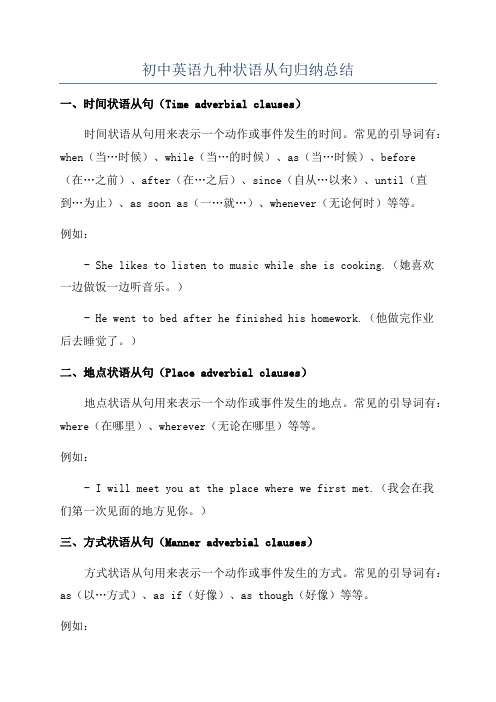
初中英语九种状语从句归纳总结一、时间状语从句(Time adverbial clauses)时间状语从句用来表示一个动作或事件发生的时间。
常见的引导词有:when(当…时候)、while(当…的时候)、as(当…时候)、before (在…之前)、after(在…之后)、since(自从…以来)、until(直到…为止)、as soon as(一…就…)、whenever(无论何时)等等。
例如:- She likes to listen to music while she is cooking.(她喜欢一边做饭一边听音乐。
)- He went to bed after he finished his homework.(他做完作业后去睡觉了。
)二、地点状语从句(Place adverbial clauses)地点状语从句用来表示一个动作或事件发生的地点。
常见的引导词有:where(在哪里)、wherever(无论在哪里)等等。
例如:- I will meet you at the place where we first met.(我会在我们第一次见面的地方见你。
)三、方式状语从句(Manner adverbial clauses)方式状语从句用来表示一个动作或事件发生的方式。
常见的引导词有:as(以…方式)、as if(好像)、as though(好像)等等。
例如:- She sang the song as if she was performing on stage.(她唱歌的时候好像在舞台上表演一样。
)- He spoke English as though he was a native speaker.(他讲英语好像是母语一样。
)四、原因状语从句(Reason adverbial clauses)原因状语从句用来表示一个动作或事件发生的原因。
常见的引导词有:because(因为)、as(因为)、since(因为)、as long as(只要)等等。
- 1、下载文档前请自行甄别文档内容的完整性,平台不提供额外的编辑、内容补充、找答案等附加服务。
- 2、"仅部分预览"的文档,不可在线预览部分如存在完整性等问题,可反馈申请退款(可完整预览的文档不适用该条件!)。
- 3、如文档侵犯您的权益,请联系客服反馈,我们会尽快为您处理(人工客服工作时间:9:00-18:30)。
§状语从句的种类(九种)口诀:▪时地原因条状补,▪目比结果方让步,▪连词引导各不同;▪主句通常前面走,▪连词引导紧随后,▪从句若在主前头,▪主从之间有个逗。
用来修饰谓语动词、其它动词、定语、状语或整个句子的从句叫做状语从句。
状语从句可分为:1.时间状语从句;(adverbial clause of time)2.地点状语从句;(adverbial clause of place)3.原因状语从句;(adverbial clause of cause)4.条件状语从句;(adverbial clause of condition)5.目的状语从句;(adverbial clause of purpose)6.让步状语从句;(adverbial clause of concession)7.比较状语从句;(adverbial clause of comparison)8.方式状语从句;(adverbial clause of manner)9.结果状语从句。
(adverbial clause of result)§状语从句的时态特点一般情况下,时间和条件状语从句的谓语动词一般用“一般现在时”表示“一般将来时”,用“现在完成时”表示“将来完成时”。
例如:1.时间状语从句;(adverbial clause of time)①由when, while, as引导的时间状语从句。
例如:When we got home, I find Tom.While my wife was reading the newspaper, I was watching TV.We always sing as we walk.我们总是边走边唱。
②由before和after引导的时间状语从句。
It will be four days before they come back. 他们要过四天才能回来。
After you think it over, please let me know what you decide.你仔细考虑过以后,告诉我你是怎样决定的。
③由till或until引导的时间状语从句。
till和until一般情况下两者可以互换,但是在强调句型中多用until。
并且要注意的是:如果主句中的谓语动词是瞬时动词时,必须用否定形式;如果主句中的谓语动词是延续性动词时,用肯定或否定形式都可以,但表达的意思不同。
I worked until he came back.我工作到他回来为止。
I didn't work until he came back.他回来我这才开始工作。
④由since引导的时间状语从句。
since引导的从句的谓语动词可以是延续性的动词,又可以是瞬时动词。
一般情况下,从句谓语动词用一般过去时,而主句的谓语动词用现在完成时。
但在It is +时间+since从句的句型中,主句多用一般现在时。
I have been in Beijing since you left. 自从你离开以来,我一直在北京了。
⑤由as soon as, immediately, directly, instantly, the moment, the instant, the minute, 等引导的时间状语从句。
这些连词都表示“一……就”。
I will go there directly I have finished my breakfast. 吃完早饭,我立即到那里。
The moment I heard the news, I hastened to the spot.我一听到消息,马上赶到了出事地点。
As soon as I reach Canada, I will ring you up. 我一到加拿大,就给你来电话。
【注意】hardly(scarcely, rarely)…when / before, no sooner…than相当于as soon as之意。
主句用过去完成时,从句用一般过去时。
当hardly, scarcely, rarely和no sooner位于句首时,主句应用倒装语序。
例如:He had no sooner arrived home than he was asked to start on another journey. 他刚到家,就被邀请开始另一旅程。
No sooner had the sun shown itself above the horizon than he got out of bed to commence work.太阳刚从地平线上升起,他就起床劳动去了。
⑥由by the time引导的时间状语从句。
注意时态的变化:在一般情况下,如果从句的谓语动词用一般过去时,主句的谓语动词用过去完成时;如果主句的谓语动词用一般现在时,主句的谓语动词用将来完成时。
By the time you came back, I had finished this book.到你回来时,我已经写完这本书了。
⑦由each time, every time和whenever引导的时间状语从句。
Each time he came to Harbin, he would call on me. 他每次来哈尔滨,总是来看我。
2.地点状语从句;(adverbial clause of place)地点状语从句一般由连接副词where, wherever等引导,已经形成了固定的句型。
句型1:Where+地点从句,(there)+主句。
Where they went, there they were warmly welcomed.他们走到哪里都受到热烈欢迎。
Where there is a will, there is a way. 有志者事竟成。
地点状语从句与定语从句的区别在于分句在句中作什么成分。
作状语,则是状语从句;作定语修饰名词,则是定语从句where引导定语从句时,从句前应有一个表示地点的名词作先行词;而状语从句前则无需先行词。
如:Go back where you came from.(where引导地点状语从句)你从何处来到何处去。
Go back to the village where you came from.(where引导定语从句,修饰village)句型2:Anywhere/ wherever+地点从句,+主句。
【注意】anywhere本身是个副词,但是,常可以引导从句,相当于连词,意思相似于wherever, anywhere引导的从句可位于主句之前,也可以位于主句之后。
而wherever本身就是个连词,表示“在何处,无论何处”。
Wherever you go, I’ll be right here waiting for you.Please put the pen where you find it.3.原因状语从句;(adverbial clause of cause)由because, as ,since引导I didn’t go ,because i was afraid。
4.条件状语从句;(adverbial clause of condition)连接条件状语从句的连接词有:if, unless, as long as.If I am not busy tomorrow, I will play football with you.You won’t pass the exam unless you work hard on it.As long as you take my advice, you will beat your rival.5.目的状语从句;(adverbial clause of purpose)连接目的状语从句的连接词有:so that, in order that.Cherry was walking quickly so that (in order that) she could arrived at the cinema in time.6.让步状语从句;(adverbial clause of concession)连接让步状语从句的连接词有:although, though, even if, even though, however, whatever, whenever, whoever, whichever.Although (though) I gave him some advice, he didn’t take them.John continued to work hard even if (even though) he felt sick.Whatever you do, I will support you.==No matter what you do, I will support you.However difficult it may be, we will overcome it. === No matter how difficult it may be, we will overcome it.7.比较状语从句;(adverbial clause of comparison)As……asShe is as tall as I(or me).He works as hard as his brother(does).thanHe is taller than I expected.8.方式状语从句;(adverbial clause of manner)连接方式状语从句的连接词有:as, as if, as though.You should do your homework as Tom does.Jerry was lying on the bed as if (as though) he was very tired.注意:通常情况下,as if等于as though.9.结果状语从句。
(adverbial clause of result)连接结果状语从句的连接词有:so…that, such…that.She spoke English so clearly that all of us could understand her.She is such a nice teacher that all of us love her.。
